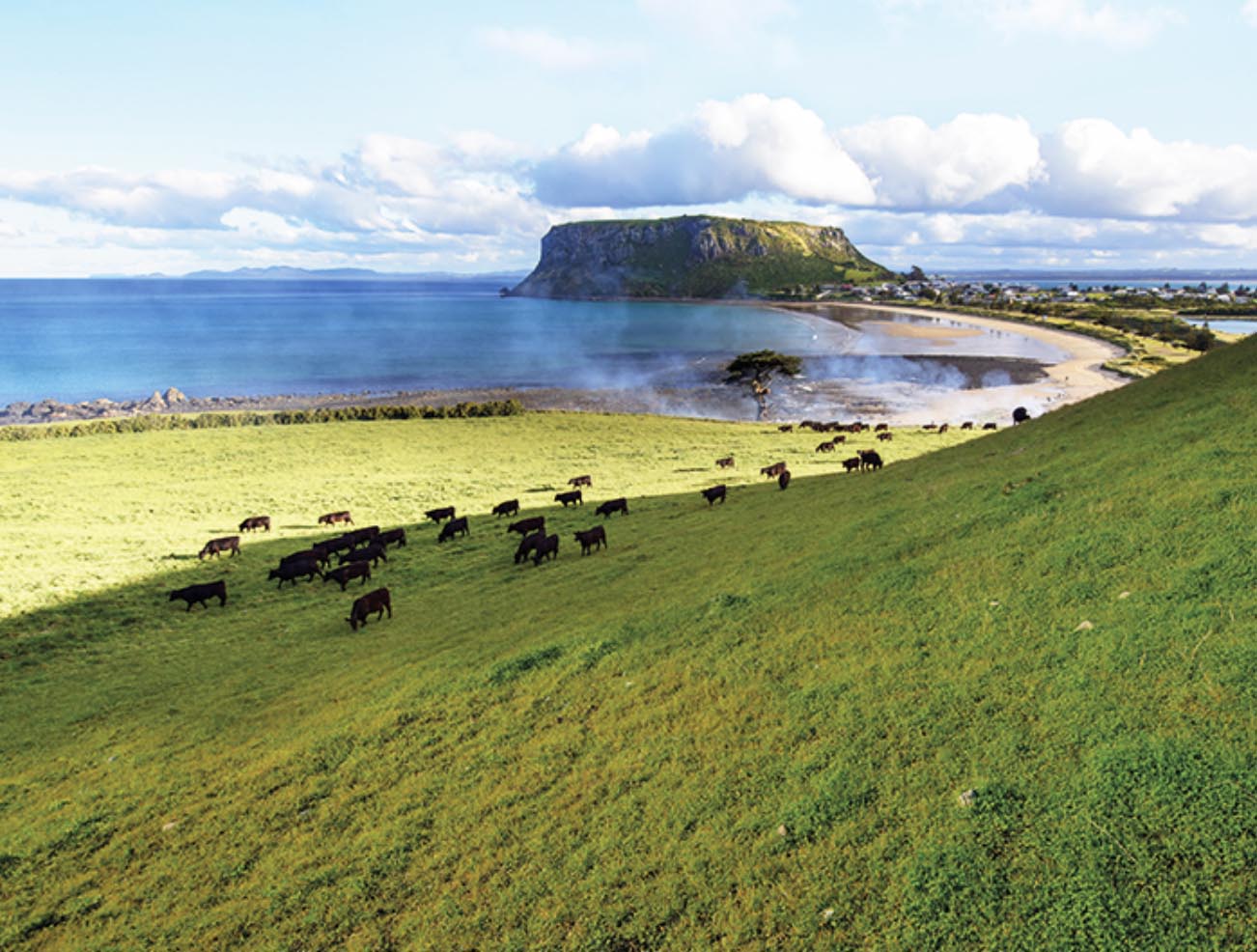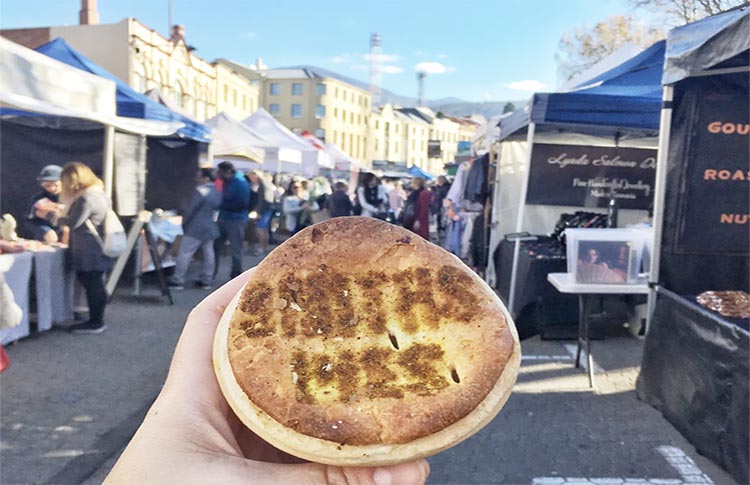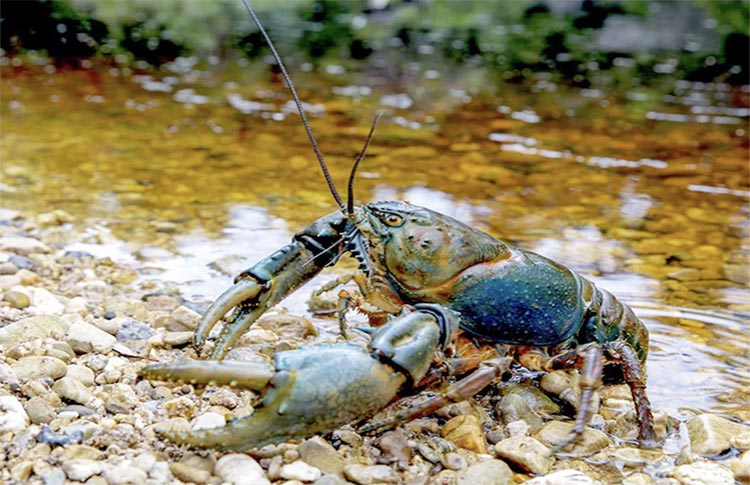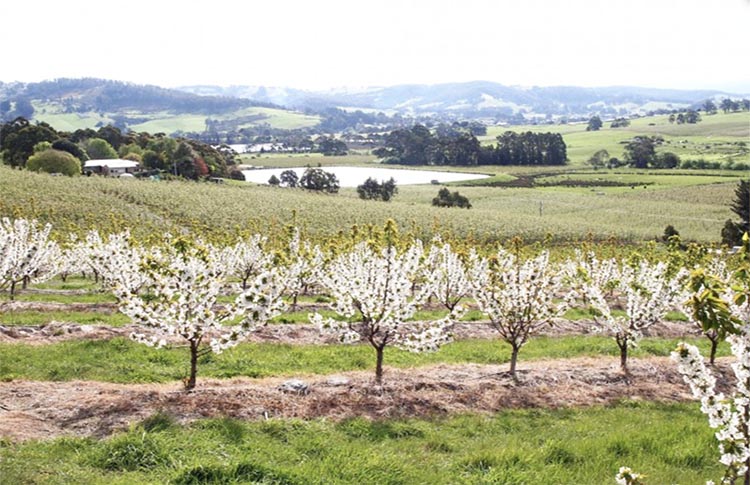
Surrounded by rich oceans and blessed with ample rainfall, fertile soils, plentiful sunshine and a moderate climate, it’s no surprise that Tasmania produces some world-class food and drink.

Read on to find out which foods, in particular, Tasmania is most famous for, as well as some suggestions for where to try them. Be sure to include any that take your fancy on your Tasmanian itinerary, because some of them you won’t be able to find anywhere else on Earth!
On this list:
Meat pies, Scallop pies, Lamb, Lobster, Salmon, Shellfish, Apples, Leatherwood honey, Olive oil, Black truffles
From the Farm
1 Meat pies
Tasmania’s plentiful rainfall and lush pastures allow year-round grazing for cattle, which has led to the island state garnering a reputation for raising some of the very best beef in the country, as well as excellent butter and dairy. Those ingredients are partnered perfectly in Tasmania’s national dish: the beautiful meat pie, which combines buttery puff pastry with succulent Tasmanian beef. Although you can find great pies all over this pie-loving island, National Pie in Hobart is the state’s most iconic bakery, pumping out thousands of pies a day, which you can enjoy here straight out of the oven.
2 Lamb
Tasmania has some of the lushest pasture in the world (enriched with a “salt-grass” effect, from sea-spray, in certain areas) with a long sheep-farming heritage. This results in high quality (and high reputation) of Tasmanian lamb. The most revered comes from Flinders Island, whose grass-fed lamb fetches high prices across Australia and the world. But local cuts from elsewhere around Tassie also feature prominently on restaurant menus across the state. Better yet, you can go straight to the source and visit Richard and Riley, from Lamb of Tasmania, near Cressy in the northeastern plains; or, get a taste of the “salt-grass” spray effect on meat quality at Wild Clover Lamb, on the northwestern coast.
Bounty of the Ocean
3 Scallop pies
Highly regarded and ubiquitous as they are, meat pies may not even be the most famous Tasmanian pie. They battle for that crown – a lofty one – with scallop pies. A distinctly Tasmanian delicacy, scallop pies typically feature fresh local scallops simmered in a creamy curry sauce and wrapped in buttery puff pastry. They have reportedly been a daily staple in seaside Tasmanian towns since the 19th century, and the best time to try them is during local scallop season, from late April to July. If you’re not heading to a small seaside town, pick one up from Smith’s or Jackman & McRoss near Hobart’s Salamanca Market, or stop in at Bakery 31 in Ross, roughly halfway between Launceston and Hobart in the Midlands

4 Lobster
Crayfish is a staple on any Tasmanian Christmas table, and habitat loss and overfishing have contributed to a decline in stocks of native freshwater crayfish (the largest freshwater invertebrate in the world), there are still plenty of places to enjoy the less endangered Southern Rock Lobster. Flinders Island is a great place to go if you’d like to catch your own, with recreational crayfish season open from November. Or, if you’re planning an East Coast Tasmanian itinerary, pop in and see Sara and Marcus at the Lobster Shack, in beautiful Bicheno, for a delicious “farmgate” experience.

5 Salmon
The marriage between introduced Atlantic salmon and the onset of large-scale aquaculture in the clean, cool harbours of Tasmania – where these species thrive – has catapulted salmon above shellfish and crustaceans in the pecking order of famous Tasmanian seafood. Tasmanian salmon farming has come under environmental scrutiny in recent years, but it’s still a major industry and international brand. For any visitors keen to get it at the source, seek out salmon farms and suppliers who adhere to the WWF-sanctioned ASC (Aquaculture Stewardship Council) regulations; or, ask the friendly staff at The Salmon Shop, near Salamanca Market in Hobart, where you can learn (and taste) what all the fuss is about!
6 Shellfish: Oysters and abalone
It’s not only in recent years that people have figured out the singular quality of Tasmanian oysters, as Aboriginal peoples have been enjoying native Angasi oysters for millennia. Today, however, after early European colonists nearly drudged the Angasi into extinction, it’s the Pacific oyster that dominates menus, oyster farms, and seafood festivals around Tassie. Conveniently, many of the best places to taste oysters in Tasmania double as idyllic seaside settings: such as Get Shucked oyster farm on Bruny Island, the Freycinet Marine Farm on the doorstep of Freycinet National Park, or the iconic Melshell Oyster Shack in Dolphin Sands, where eating local oysters is, according to their slogan, “like French kissing a mermaid”.

From the Fields
7 Apples
Before salmon and whisky stole the show, Tasmania was best-known to those on the Australian mainland (and beyond) as “the Apple Isle''. Although long past its post-colonial heyday, Tasmania’s apple industry is still alive and well, producing a massive range of local heirloom varieties whose diverse taste characteristics are a world apart from bland, modern, standardised supermarket apples. Visit Glenburn Orchards, near Hobart, or Millers Orchard, near Launceston, for quality apples straight from the tree. Or, sample Tasmania’s apple heritage in another form: through the famous Tasmanian apple sponge cake (often sour as well as sweet), or by visiting one of the many apple-cider cellar doors that dot the plains and valleys emanating from Launceston and Hobart

8 Leatherwood honey
It may not be as famous overseas as varieties such as New Zealand manuka honey, but the bees buzzing between bountiful leatherwood trees of Tasmania’s west coast rainforests quietly go about their business, producing a truly unique, complex honey that is quietly gaining acclaim around the world. There’s no other place on Earth to taste it straight from the source, so any honey-loving travellers visiting Cradle Mountain, the Tarkine rainforest, the Central Highlands, or the northwest coast on their Tasmanian itinerary will want to make a point of stopping in at Mole Creek, Blue Hills, or one of many other honey farms and factory doors across the region.
9 Olive oil
Like leatherwood honey, Tasmanian olive oil is building a stronger and stronger reputation among health-conscious eaters and discerning diners around the world. Renowned for a higher-than-average oleic acid content, plus low levels of saturated fat, Tasmanian olive oil is among the healthiest oils you can find on the market. The trouble is: most of it doesn’t make it past local markets. Therefore, don’t miss the chance to snare some from one of Tasmania’s local farmer's markets while you’re here. Or, head straight to the source at Riverstone Olives near Freycinet National Park, Lentara Grove in the Tamar Valley, or Cradle Coast Olives in the northwest.
10 Black truffles
Since first being inoculated into local tree roots in the 1990s, highly prized black truffles (known as Périgord truffles in France) have proven perfectly suited to the fertile soils, moderate seasonal climate, and pristine air of central-northern Tasmania. You will find Tasmanian truffles at restaurants in Hobart, Launceston, and across the state, but for a really special experience, take it a step further and accompany the dogs (note: not pigs, as is done in Europe) on a truffle hunt at the Truffledore on Cradle Country Farm, in the foothills of Cradle Mountain, or at Tasmanian Truffles and The Truffle Farm, on the way to the fabulous Great Western Tier mountains.
If you like the sound of these famous Tasmanian foods, visit FLT’s Tasmania blog page for more inspiration and information on where to say, what to see and what else to do while tasting them in Tassie.
There’s also a range of expertly arranged self-drive itinerary packages to choose from, many of which already incorporate a chance to taste the foods mentioned above.
Or, feel free to contact FLT’s travel-planning experts directly. They’ll be able to answer any questions, or help you plan your own customised Tasmanian travel itinerary!
Recent Posts
Blog Categories
Blog archives
- March 2025 (1)
- November 2024 (1)
- October 2024 (1)
- September 2024 (8)
- June 2024 (4)
- May 2024 (2)
- April 2024 (2)
- March 2024 (13)
- February 2024 (3)
- January 2024 (5)
- December 2023 (6)
- November 2023 (4)
- October 2023 (11)
- September 2023 (2)
- August 2023 (6)
- July 2023 (2)
- June 2023 (17)
- May 2023 (3)
- April 2023 (5)
- March 2023 (8)
- February 2023 (9)
- January 2023 (12)
- December 2022 (9)
- November 2022 (12)
- October 2022 (12)
- September 2022 (12)
- August 2022 (6)
- July 2022 (9)
- June 2022 (7)
- May 2022 (3)
- April 2022 (4)
- March 2022 (6)
- February 2022 (1)
- January 2022 (4)
- December 2021 (2)
- November 2021 (3)
- October 2021 (1)
- September 2021 (4)
- August 2021 (10)
- July 2021 (13)
- June 2021 (6)
- April 2021 (2)
- March 2021 (2)
- February 2021 (1)
- January 2021 (1)
- December 2020 (2)
- November 2020 (3)
- October 2020 (2)
- September 2020 (1)
- August 2020 (1)
- July 2020 (1)
- June 2020 (1)
- May 2020 (1)
- March 2020 (1)
- February 2020 (2)
- January 2020 (4)
- December 2019 (2)
- November 2019 (1)
- October 2019 (1)
- September 2019 (5)
- August 2019 (1)
- July 2019 (5)
- June 2019 (1)
- May 2019 (1)
- April 2019 (1)
- March 2019 (1)
- February 2019 (1)
- January 2019 (1)
- December 2018 (1)
- October 2018 (1)
- May 2018 (1)
- February 2018 (1)
- December 2017 (1)
- October 2017 (1)
- June 2017 (1)
- May 2017 (1)
- February 2017 (1)
- January 2017 (1)
- September 2016 (1)
- August 2016 (2)
- July 2016 (1)
- June 2016 (1)
- May 2016 (1)
- April 2016 (1)
- December 2015 (1)



